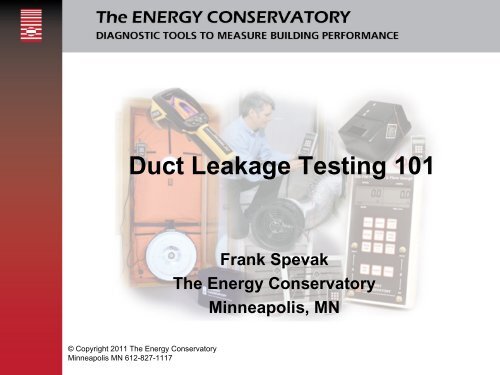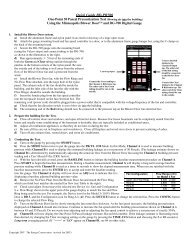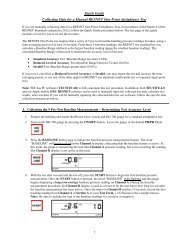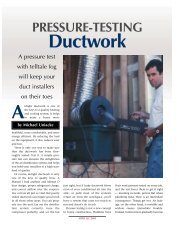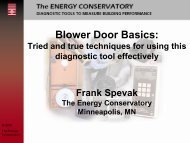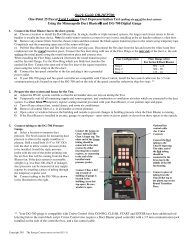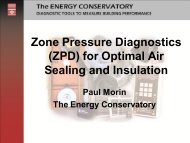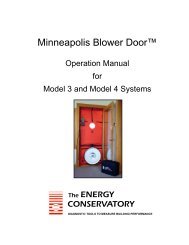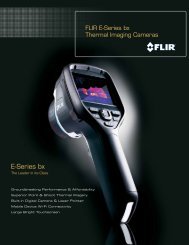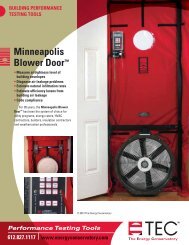Duct Leakage Testing 101 - The Energy Conservatory
Duct Leakage Testing 101 - The Energy Conservatory
Duct Leakage Testing 101 - The Energy Conservatory
Create successful ePaper yourself
Turn your PDF publications into a flip-book with our unique Google optimized e-Paper software.
<strong>Duct</strong> <strong>Leakage</strong> <strong>Testing</strong> <strong>101</strong>Frank Spevak<strong>The</strong> <strong>Energy</strong> <strong>Conservatory</strong>Minneapolis, MN© Copyright 2011 <strong>The</strong> <strong>Energy</strong> <strong>Conservatory</strong>Minneapolis MN 612-827-1117
Housekeeping• If you do not hear anything from your computer’sspeaker system you will need to dial in and listento the presentation over the phone• If you have a question or a comment about thepresentation, please type your message in thebox at the lower right hand portion of the screen• If the image is larger than your screen you havescroll bars on the right and bottom to position thescreen for your best viewing• Copies of the slides will be on <strong>The</strong> <strong>Energy</strong><strong>Conservatory</strong> website in about 2 weeks
Housekeeping• If you lose your connection, close your browser,restart your browser and then join the webinaragain• BPI credits can only be issued for attending a livebroadcast of the webinar• If you wish to receive BPI credits for this webinar,you will need to make sure that your name isregistered for the webinar• BPI will be notified of your attendance in about aweek• You will also need to send an email toinfo@energyconservatory.com with your nameand BPI certificate number
Agenda• <strong>Duct</strong> <strong>Leakage</strong> and Interactions• Types of <strong>Duct</strong> <strong>Leakage</strong> Tests– Total <strong>Duct</strong> <strong>Leakage</strong>– <strong>Duct</strong> <strong>Leakage</strong> to Outside• Set-up for Total <strong>Duct</strong> <strong>Leakage</strong>• Set-up for <strong>Duct</strong> <strong>Leakage</strong> to Outside• Discussion of <strong>Leakage</strong> Results• <strong>Duct</strong> Blaster® Calibration• Other Tests Using a <strong>Duct</strong> Blaster®
<strong>Duct</strong> <strong>Leakage</strong> Interactions
Common <strong>Leakage</strong> Locations
Common <strong>Leakage</strong> Locations
Types of <strong>Duct</strong> <strong>Leakage</strong> Tests• Total <strong>Duct</strong> <strong>Leakage</strong>– Pressurize (or depressurize) duct work.– <strong>Duct</strong> Blaster® connected to central return or airhandler.– Measure air flow (CFM) needed to pressurizeducts to 25 Pa.– Measures all duct leaks.
Total <strong>Leakage</strong> Test• Measures all leaks in the duct system, bothinside and outside of the building.
Types of <strong>Duct</strong> <strong>Leakage</strong> Tests• <strong>Duct</strong> <strong>Leakage</strong> to Outside– Pressurize (or depressurize) duct work.– <strong>Duct</strong> Blaster connected to central return or airhandler– Blower Door operating to pressurize house to25 Pa.– Measure air flow (CFM) needed to equalizepressure in ducts to 0 Pa.– Measures only duct leaks to outside thebuilding envelope (e.g. attics, crawlspaces,garages).
Outside <strong>Leakage</strong> Test• Does not include duct leakage to inside thebuilding.
Total vs. Outside <strong>Leakage</strong> TestTotal <strong>Leakage</strong> Test:Pro:– Can do test at rough-in.– Shorter set-up time/easier test.– Less equipment needed.Con:– Often results in larger leakage measurement thanOutside test (unless all ducts are outside of thebuilding).– Harder to meet <strong>Energy</strong> Star requirements ifleakage number is bigger.– If testing at rough-in, often have to accept penaltyfor missing register grilles (2.5%), and missing airhandler (2.5%).
Total vs. Outside <strong>Leakage</strong> TestOutside <strong>Leakage</strong> Test:Pro:– Often results in smaller leakage measurementthan Total test (unless all ducts outside).– Easier to meet <strong>Energy</strong> Star requirement if leakagemeasurement is smaller.Con:– Longer set-up time.– More equipment needed (Blower Door).– Must wait until building envelope completedbefore conducting test.
Total <strong>Leakage</strong> Test (Pressurization)Conducting a Total <strong>Leakage</strong> Test
Total <strong>Leakage</strong> Test• Connect the <strong>Duct</strong> <strong>Testing</strong>Fan to either:– <strong>The</strong> largest return grille, or– <strong>The</strong> blower access door.
Total <strong>Leakage</strong> Test• Install the Flow Ring on the fan that youthink best matches the needed fan flow(can always change Ring during test).Fan Configuration Flow Range (cfm)For Series B <strong>Duct</strong> BlasterOpen (no Flow Ring) 1,500 - 600Ring 1 800 – 225Ring 2 300 – 90Ring 3 125 – 10
Total <strong>Leakage</strong> Test• Turn off the air handlerso that it does not comeon during test.• Temporarily seal off allremaining supply andreturn registers usingpainters tape, <strong>Duct</strong> Maskor other temporary seal.
Total <strong>Leakage</strong> Test• Turn off exhaust fans, dryers etc.• Remove all filters from the duct system.• Open a door or window between thehouse and outside (prevents changes inhouse pressure during the test), andinterior doors.• Open access doors from unconditionedspaces (e.g. attics) containing ducts tooutside.
Total <strong>Leakage</strong> Test• Select a location to measureduct pressure.– Either in the supply plenum,supply trunkline, or at asupply register.– In a tight duct system (i.e.< 200 CFM25), locationchoice will have very littleeffect on results.– In zoned systems, musthave dampers open, or willneed to test each supply runseparately (this is a bigproblem).
Total <strong>Leakage</strong> Test• Connect tubing to the DG-700 Gauge.– Green tubing from ductpressure probe to Input ofChannel A.– Red tubing from <strong>Duct</strong>Blaster fan to input ofChannel B.
Total <strong>Leakage</strong> Test• Put DG-700 in PR/ FL @25 Mode, enter Deviceand Configuration, adjust fan to about 25 Paduct pressure on Channel A.– Gauge displays CFM25 on Channel B. (Can’tReach 25 Factor is built-in to the flow reading)– Saves time - no need to adjust test pressure toexactly 25 Pa - just get close (20 - 30).– In very leaky duct systems, displays leakageestimate if <strong>Duct</strong> Pressure is at least 5 Pa.
Outside <strong>Leakage</strong> Test (Pressurization)
Outside <strong>Leakage</strong> Test• When possible, unconditioned zonescontaining ducts shall be opened tooutside and conditioned zones containingducts shall be opened to inside. If this isnot possible, leave as is.• Windows and doors to outside must beclosed.• Prepare house for a Blower Door test.– Water heater on pilot.– Turn off heating and cooling system.
Outside <strong>Leakage</strong> Test• Seal off all registers and returns as in a Total<strong>Duct</strong> <strong>Leakage</strong> Test.• <strong>Duct</strong> <strong>Testing</strong> Fan set up is the same as Total<strong>Leakage</strong> Test.• Install Blower Door fan to pressurize house (notmeasuring flow from Blower Door fan).
Outside <strong>Leakage</strong> Test (Blower Door)• Start DG-700 gauge onthe Blower Door and goto the Cruise Mode.• Set for 25 Pa.• Start fan to maintainhouse at 25 Pa.
Outside <strong>Leakage</strong> Test• With <strong>Duct</strong> Blaster DG-700,connect tubing to the gauge(same as Total <strong>Leakage</strong> Test).– Green tubing from ductpressure probe to Input ofChannel A.– Red tubing from <strong>Duct</strong> Blasterfan to input of Channel B.
Outside <strong>Leakage</strong> Test• Put DG-700 in PR/ FL Mode (not PR/ FL @25),enter Device and Configuration.• With Blower Door pressurizing building to 25 Pa,adjust <strong>Duct</strong> Blaster to create zero pressurebetween ducts and building (Channel A). Flowvalue from Channel B is the measured leakage.
Tips and Troubleshooting• When performing a <strong>Leakage</strong> to Outside Test,perform a Total <strong>Leakage</strong> Test first to determineif house passes without the Outside Test.• Also provides you with an maximum leakagenumber. <strong>The</strong> Outside Test can not have anumber larger than the Total Test.• Remember, for Outside Test, have the gauge inPL/FL mode not PL/FL@25 mode – commonerror.
<strong>Leakage</strong> Results• Any duct leakage that is outside of the buildingenvelope creates an energy penalty as well as airquality problem.• <strong>Duct</strong> leakage to the inside is not a large energypenalty, but can contribute to problems related todelivery of air, comfort issues and other problemsrelated to pressurization or depressurization of thehouse.• Be aware that sealing all ductwork can causeother problems related to the air handler orcombustion safety.
<strong>Leakage</strong> Results• How much leakage are we talking about?• Retrofit:– House system has 2 ½ tons of cooling.– At 400 CFM per ton equals 1,000 CFM.– Retrofit @ 15% = 150 CFM25 of total leakage.• New construction:– 1000 square feet– <strong>Energy</strong> Star @ 6% equals 60 CFM25 of leakageto the outside
<strong>Duct</strong> <strong>Leakage</strong> Impacts• Example –– Outside duct leakage test results are 300 CFM25on a 2 ½ ton system.– Assuming the leaks are split equally betweensupply and return, the result is a 22.5% annualenergy penalty.– A 12 SEER system is now only 9.3.– An 80% furnace is now only 62%.• <strong>Duct</strong> <strong>Leakage</strong> to Outside is a direct energypenalty for heating and cooling.
<strong>Duct</strong> Blaster Field Calibration Plate• Used to perform a fieldcalibration check on yourSeries B Minneapolis <strong>Duct</strong>Blaster System (with DG-700 gauge).• Designed to simulate a ductleakage test with a leakagerate of 106 CFM @25 Pa.
Other uses of the <strong>Duct</strong> Blaster• <strong>Duct</strong> Blaster Fan can beused as a Blower Door.– Small, tight houses.– Need new nylon panelsized for the <strong>Duct</strong>Blaster Fan.
Other uses of the <strong>Duct</strong> Blaster• <strong>Duct</strong> Blaster as Powered Capture Hood.– Accurately measure flow at supply or returnregisters.– Bulky, but very accurate and easily modified forunusual register locations such as toe kicks.
Updates Coming to <strong>Duct</strong> Blaster®• New Digital Fan Speed Controller – allows userto perform an automated test• New rechargeable battery pack – allows user toperform lower flow tests without connecting to awall outlet• New FlowBlaster add-on – to measure supplyand return flows through registers and grills• Expected availability 2 nd quarter 2011• Pricing and updates will be on website andenewsletters
Other Resources• Visit <strong>The</strong> <strong>Energy</strong> <strong>Conservatory</strong> website– www.energyconservatory.com– All manuals and literature.– Training contacts and annual conferences.– <strong>Duct</strong> Blaster Quick Guide Video.
• Any further questionsThank you


